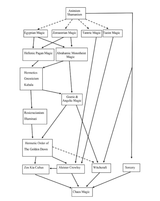Anonymous
6/21/2025, 6:28:52 PM No.40574781
https://sacred-texts.com/bos/bos065.htm
Magic Frameworks can be broken down into following (summarised via ai in link above)
>1. Spirit Model
Definition: Magic is effected by communication or coercion of non-physical beings (spirits, deities).
Technique: Trance, shamanic journeying, invocation, exorcism.
Worldview: Dual-realm cosmology—physical world and a spirit world overlap.
Example Phrase: "Fence-rider" — one who travels between the two worlds.
>2. Energy Model
Definition: Magic works by manipulating subtle, universal energies.
Sources: Qi, Prana, Od, Astral Light, Mana.
Technique: Hands-on healing, breathwork, chakra work, magnetism.
Worldview: No spirits needed; energy dynamics govern outcomes.
>3. Psychological Model
Definition: Magic is psychological manipulation of the subconscious.
Technique: Sigils, symbols, trance, self-hypnosis.
Key Concept: The unconscious mind executes magical intent.
Founder Figures: Sigmund Freud (subconscious), Carl Jung (archetypes), Austin Osman Spare (sigil magic).
>4. Information Model
Definition: Magic is the manipulation and transmission of non-material information.
Technique: Cybermagic, "copy/paste" commands, symbolic language.
Notable Idea: Information travels outside space-time limits.
Tools: Memory banks (brain/spine), morphic fields (à la Sheldrake), information matrices.
>5. Meta-Model
Definition: Magic is best practiced by choosing the most appropriate model based on context.
Philosophy: "Nothing is true, everything is permitted."
Usage: Practicality over dogma—models can shift mid-operation.
Challenge: Requires comfort with paradigm fluidity and rejection of absolutes.
>Final Insights
Models are tools, not truths: Each is a lens for viewing magical processes.
No model is complete: Mixing models can be powerful but demands flexibility.
Application is key: The most efficient, context-sensitive model should be used—not the most "true".
Magic Frameworks can be broken down into following (summarised via ai in link above)
>1. Spirit Model
Definition: Magic is effected by communication or coercion of non-physical beings (spirits, deities).
Technique: Trance, shamanic journeying, invocation, exorcism.
Worldview: Dual-realm cosmology—physical world and a spirit world overlap.
Example Phrase: "Fence-rider" — one who travels between the two worlds.
>2. Energy Model
Definition: Magic works by manipulating subtle, universal energies.
Sources: Qi, Prana, Od, Astral Light, Mana.
Technique: Hands-on healing, breathwork, chakra work, magnetism.
Worldview: No spirits needed; energy dynamics govern outcomes.
>3. Psychological Model
Definition: Magic is psychological manipulation of the subconscious.
Technique: Sigils, symbols, trance, self-hypnosis.
Key Concept: The unconscious mind executes magical intent.
Founder Figures: Sigmund Freud (subconscious), Carl Jung (archetypes), Austin Osman Spare (sigil magic).
>4. Information Model
Definition: Magic is the manipulation and transmission of non-material information.
Technique: Cybermagic, "copy/paste" commands, symbolic language.
Notable Idea: Information travels outside space-time limits.
Tools: Memory banks (brain/spine), morphic fields (à la Sheldrake), information matrices.
>5. Meta-Model
Definition: Magic is best practiced by choosing the most appropriate model based on context.
Philosophy: "Nothing is true, everything is permitted."
Usage: Practicality over dogma—models can shift mid-operation.
Challenge: Requires comfort with paradigm fluidity and rejection of absolutes.
>Final Insights
Models are tools, not truths: Each is a lens for viewing magical processes.
No model is complete: Mixing models can be powerful but demands flexibility.
Application is key: The most efficient, context-sensitive model should be used—not the most "true".
Replies:
